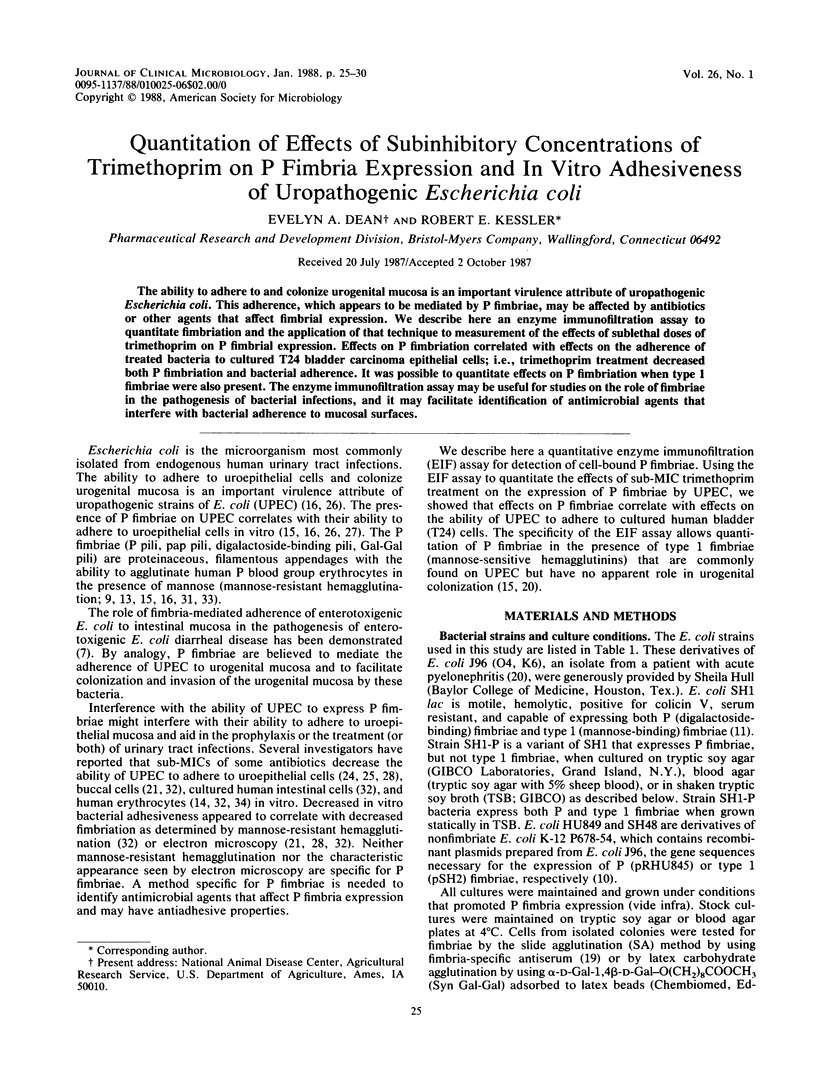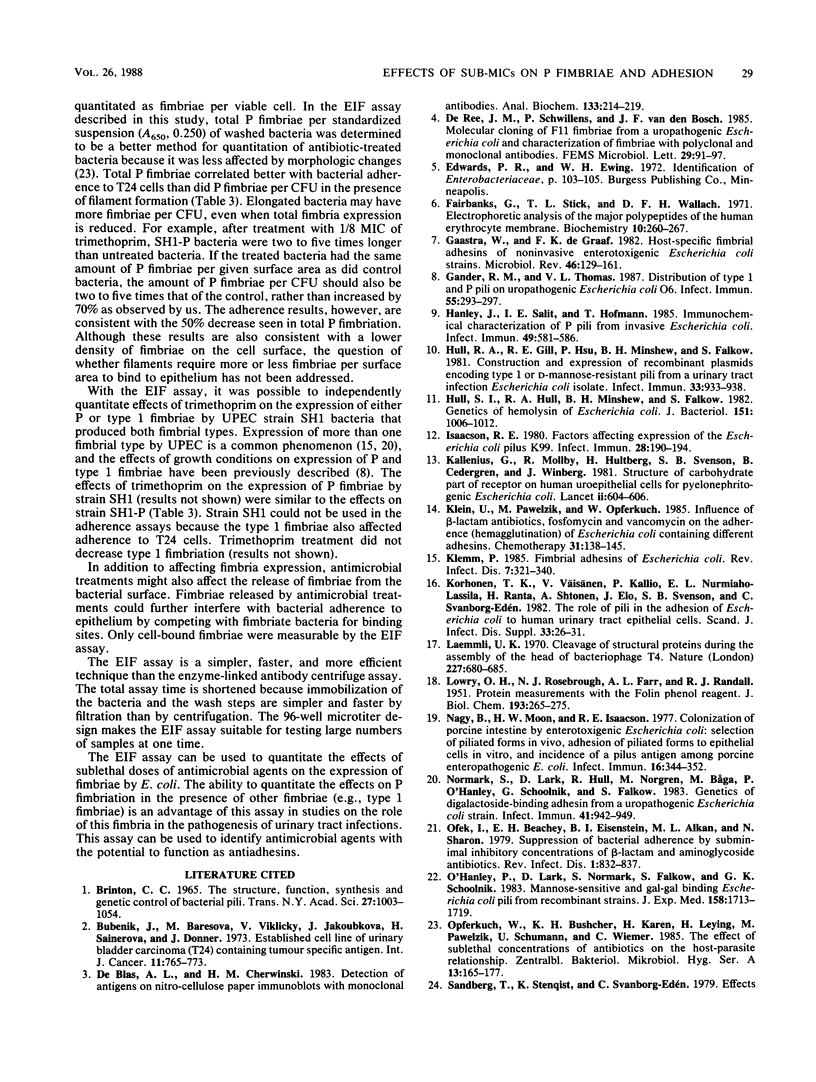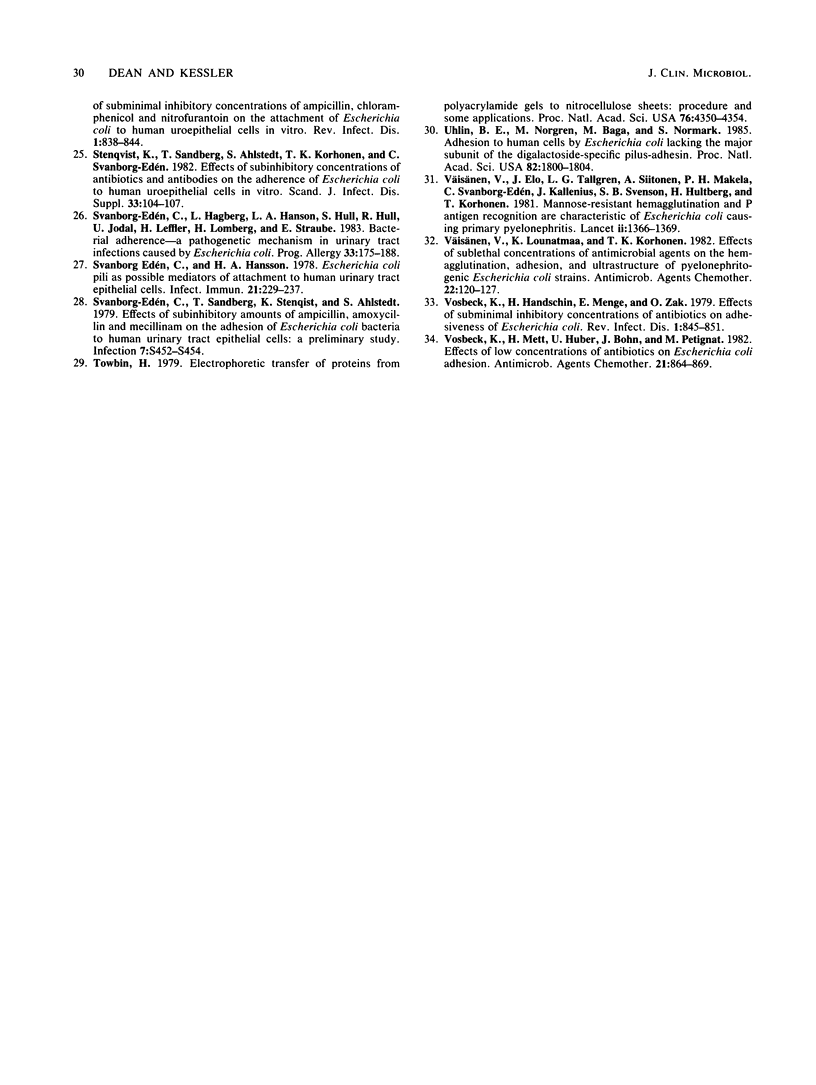Abstract
The ability to adhere to and colonize urogenital mucosa is an important virulence attribute of uropathogenic Escherichia coli. This adherence, which appears to be mediated by P fimbriae, may be affected by antibiotics or other agents that affect fimbrial expression. We describe here an enzyme immunofiltration assay to quantitate fimbriation and the application of that technique to measurement of the effects of sublethal doses of trimethoprim on P fimbrial expression. Effects on P fimbriation correlated with effects on the adherence of treated bacteria to cultured T24 bladder carcinoma epithelial cells; i.e., trimethoprim treatment decreased both P fimbriation and bacterial adherence. It was possible to quantitate effects on P fimbriation when type 1 fimbriae were also present. The enzyme immunofiltration assay may be useful for studies on the role of fimbriae in the pathogenesis of bacterial infections, and it may facilitate identification of antimicrobial agents that interfere with bacterial adherence to mucosal surfaces.
Full text
PDF





Images in this article
Selected References
These references are in PubMed. This may not be the complete list of references from this article.
- Brinton C. C., Jr The structure, function, synthesis and genetic control of bacterial pili and a molecular model for DNA and RNA transport in gram negative bacteria. Trans N Y Acad Sci. 1965 Jun;27(8):1003–1054. doi: 10.1111/j.2164-0947.1965.tb02342.x. [DOI] [PubMed] [Google Scholar]
- Bubeník J., Baresová M., Viklický V., Jakoubková J., Sainerová H., Donner J. Established cell line of urinary bladder carcinoma (T24) containing tumour-specific antigen. Int J Cancer. 1973 May;11(3):765–773. doi: 10.1002/ijc.2910110327. [DOI] [PubMed] [Google Scholar]
- De Blas A. L., Cherwinski H. M. Detection of antigens on nitrocellulose paper immunoblots with monoclonal antibodies. Anal Biochem. 1983 Aug;133(1):214–219. doi: 10.1016/0003-2697(83)90245-2. [DOI] [PubMed] [Google Scholar]
- Edén C. S., Hansson H. A. Escherichia coli pili as possible mediators of attachment to human urinary tract epithelial cells. Infect Immun. 1978 Jul;21(1):229–237. doi: 10.1128/iai.21.1.229-237.1978. [DOI] [PMC free article] [PubMed] [Google Scholar]
- Gaastra W., de Graaf F. K. Host-specific fimbrial adhesins of noninvasive enterotoxigenic Escherichia coli strains. Microbiol Rev. 1982 Jun;46(2):129–161. doi: 10.1128/mr.46.2.129-161.1982. [DOI] [PMC free article] [PubMed] [Google Scholar]
- Gander R. M., Thomas V. L. Distribution of type 1 and P pili on uropathogenic Escherichia coli O6. Infect Immun. 1987 Feb;55(2):293–297. doi: 10.1128/iai.55.2.293-297.1987. [DOI] [PMC free article] [PubMed] [Google Scholar]
- Hanley J., Salit I. E., Hofmann T. Immunochemical characterization of P pili from invasive Escherichia coli. Infect Immun. 1985 Sep;49(3):581–586. doi: 10.1128/iai.49.3.581-586.1985. [DOI] [PMC free article] [PubMed] [Google Scholar]
- Hull R. A., Gill R. E., Hsu P., Minshew B. H., Falkow S. Construction and expression of recombinant plasmids encoding type 1 or D-mannose-resistant pili from a urinary tract infection Escherichia coli isolate. Infect Immun. 1981 Sep;33(3):933–938. doi: 10.1128/iai.33.3.933-938.1981. [DOI] [PMC free article] [PubMed] [Google Scholar]
- Hull S. I., Hull R. A., Minshew B. H., Falkow S. Genetics of hemolysin of Escherichia coli. J Bacteriol. 1982 Aug;151(2):1006–1012. doi: 10.1128/jb.151.2.1006-1012.1982. [DOI] [PMC free article] [PubMed] [Google Scholar]
- Isaacson R. E. Factors affecting expression of the Escherichia coli pilus K99. Infect Immun. 1980 Apr;28(1):190–194. doi: 10.1128/iai.28.1.190-194.1980. [DOI] [PMC free article] [PubMed] [Google Scholar]
- Klein U., Pawelzik M., Opferkuch W. Influence of beta-lactam antibiotics, fosfomycin and vancomycin on the adherence (hemagglutination) of Escherichia coli-containing different adhesins. Chemotherapy. 1985;31(2):138–145. doi: 10.1159/000238326. [DOI] [PubMed] [Google Scholar]
- Klemm P. Fimbrial adhesions of Escherichia coli. Rev Infect Dis. 1985 May-Jun;7(3):321–340. doi: 10.1093/clinids/7.3.321. [DOI] [PubMed] [Google Scholar]
- Korhonen T. K., Väisänen V., Kallio P., Nurmiaho-Lassila E. L., Ranta H., Siitonen A., Elo J., Svenson S. B., Svanborg-Edén C. The role of pili in the adhesion of Escherichia coli to human urinary tract epithelial cells. Scand J Infect Dis Suppl. 1982;33:26–31. [PubMed] [Google Scholar]
- Källenius G., Svenson S., Möllby R., Cedergren B., Hultberg H., Winberg J. Structure of carbohydrate part of receptor on human uroepithelial cells for pyelonephritogenic Escherichia coli. Lancet. 1981 Sep 19;2(8247):604–606. doi: 10.1016/s0140-6736(81)92743-4. [DOI] [PubMed] [Google Scholar]
- LOWRY O. H., ROSEBROUGH N. J., FARR A. L., RANDALL R. J. Protein measurement with the Folin phenol reagent. J Biol Chem. 1951 Nov;193(1):265–275. [PubMed] [Google Scholar]
- Laemmli U. K. Cleavage of structural proteins during the assembly of the head of bacteriophage T4. Nature. 1970 Aug 15;227(5259):680–685. doi: 10.1038/227680a0. [DOI] [PubMed] [Google Scholar]
- Nagy B., Moon H. W., Isaacson R. E. Colonization of porcine intestine by enterotoxigenic Escherichia coli: selection of piliated forms in vivo, adhesion of piliated forms to epithelial cells in vitro, and incidence of a pilus antigen among porcine enteropathogenic E. coli. Infect Immun. 1977 Apr;16(1):344–352. doi: 10.1128/iai.16.1.344-352.1977. [DOI] [PMC free article] [PubMed] [Google Scholar]
- Normark S., Lark D., Hull R., Norgren M., Båga M., O'Hanley P., Schoolnik G., Falkow S. Genetics of digalactoside-binding adhesin from a uropathogenic Escherichia coli strain. Infect Immun. 1983 Sep;41(3):942–949. doi: 10.1128/iai.41.3.942-949.1983. [DOI] [PMC free article] [PubMed] [Google Scholar]
- O'Hanley P., Lark D., Normark S., Falkow S., Schoolnik G. K. Mannose-sensitive and Gal-Gal binding Escherichia coli pili from recombinant strains. Chemical, functional, and serological properties. J Exp Med. 1983 Nov 1;158(5):1713–1719. doi: 10.1084/jem.158.5.1713. [DOI] [PMC free article] [PubMed] [Google Scholar]
- Ofek I., Beachey E. H., Eisenstein B. I., Alkan M. L., Sharon N. Suppression of bacterial adherence by subminimal inhibitory concentrations of beta-lactam and aminoglycoside antibiotics. Rev Infect Dis. 1979 Sep-Oct;1(5):832–837. doi: 10.1093/clinids/1.5.832. [DOI] [PubMed] [Google Scholar]
- Stenqvist K., Sandberg T., Ahlstedt S., Korhonen T. K., Svanborg-Edén C. Effects of subinhibitory concentrations of antibiotics and antibodies on the adherence of Escherichia coli to human uroepithelial cells in vitro. Scand J Infect Dis Suppl. 1982;33:104–107. [PubMed] [Google Scholar]
- Svanborg Edén C., Hagberg L., Hanson L. A., Hull S., Hull R., Jodal U., Leffler H., Lomberg H., Straube E. Bacterial adherence--a pathogenetic mechanism in urinary tract infections caused by Escherichia coli. Prog Allergy. 1983;33:175–188. [PubMed] [Google Scholar]
- Svanborg-Edén C., Sandberg T., Stenqvist K., Ahlstedt S. Effects of subinhibitory amounts of ampicillin, amoxycillin and mecillinam on the adhesion of Escherichia coli bacteria to human urinary tract epithelial cells: a preliminary study. Infection. 1979;7 (Suppl 5):S452–S455. doi: 10.1007/BF01659769. [DOI] [PubMed] [Google Scholar]
- Towbin H., Staehelin T., Gordon J. Electrophoretic transfer of proteins from polyacrylamide gels to nitrocellulose sheets: procedure and some applications. Proc Natl Acad Sci U S A. 1979 Sep;76(9):4350–4354. doi: 10.1073/pnas.76.9.4350. [DOI] [PMC free article] [PubMed] [Google Scholar]
- Uhlin B. E., Norgren M., Båga M., Normark S. Adhesion to human cells by Escherichia coli lacking the major subunit of a digalactoside-specific pilus-adhesin. Proc Natl Acad Sci U S A. 1985 Mar;82(6):1800–1804. doi: 10.1073/pnas.82.6.1800. [DOI] [PMC free article] [PubMed] [Google Scholar]
- Vosbeck K., Handschin H., Menge E. B., Zak O. Effects of subminimal inhibitory concentrations of antibiotics on adhesiveness of Escherichia coli in vitro. Rev Infect Dis. 1979 Sep-Oct;1(5):845–851. doi: 10.1093/clinids/1.5.845. [DOI] [PubMed] [Google Scholar]
- Vosbeck K., Mett H., Huber U., Bohn J., Petignat M. Effects of low concentrations of antibiotics on Escherichia coli adhesion. Antimicrob Agents Chemother. 1982 Jun;21(6):864–869. doi: 10.1128/aac.21.6.864. [DOI] [PMC free article] [PubMed] [Google Scholar]
- Väisänen V., Lounatmaa K., Korhonen T. K. Effects of sublethal concentrations of antimicrobial agents on the hemagglutination, adhesion, and ultrastructure of pyelonephritogenic Escherichia coli strains. Antimicrob Agents Chemother. 1982 Jul;22(1):120–127. doi: 10.1128/aac.22.1.120. [DOI] [PMC free article] [PubMed] [Google Scholar]



